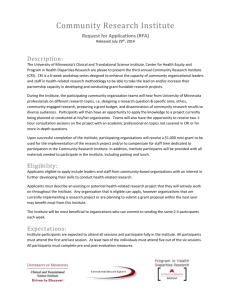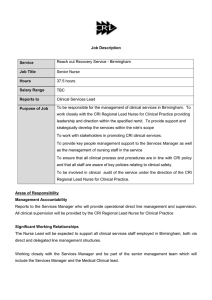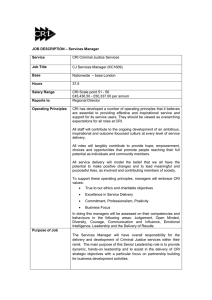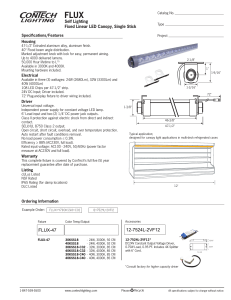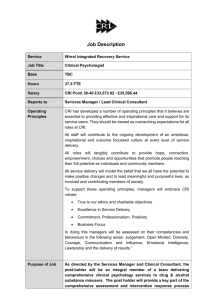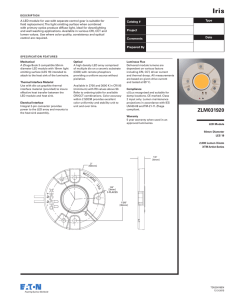Computer Related Injury
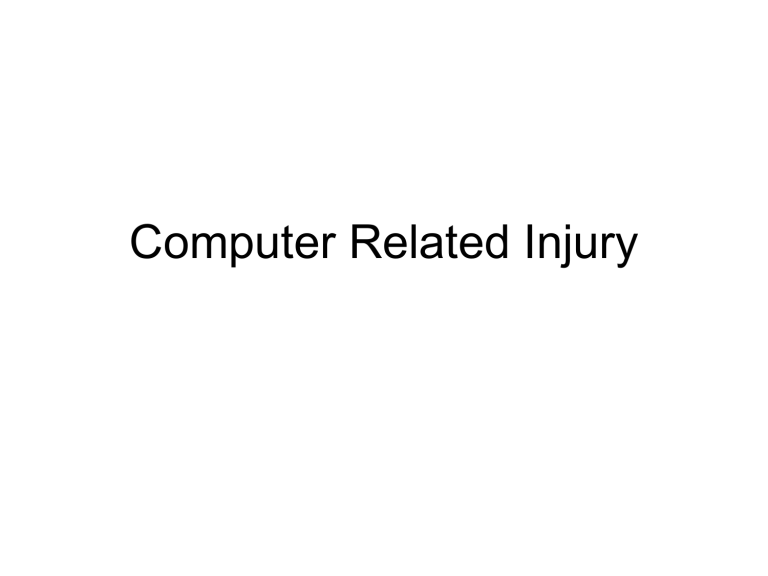
Computer Related Injury
Computer Related Injuries (CRI,
RSI etc)
• Painful debilitating condition refers to damage to the muscles, tendons, ligaments, blood vessels, nerves & other soft tissues of the upper extremity & back.
Magnitude of problem of CRI
• 20-25% computer users
• 60% of all occupational illnesses (since
1991, in US)
• Cost of compensation in US: over $20 billion/ per year
Causes of CRI
• Improper use & lack of knowledge about safe computing techniques
• Results from repeated force on soft tissues over a prolonged period
• Repeated trauma causes micro-tears to the affected part, hence leading to inflammation & subsequently to the disorder
Who is at risk for CRI?
• Any one using computers more than 2hrs/ day:
-software professionals
-secretaries, clerks
-cashiers, bank officers
-students
-journalists
Common presentations of CRI
• Parts affected : fingers, upper arm, shoulders, neck, lower back. legs etc
• Symptoms : ache or pains,numbness or hypersensitivity, tingling, coldness or burning, weakness, feeling of heaviness, stiffness or tightness, a constant need to stretch or massage, difficulty in day to day activities, e.g, shaking hands, opening doors, dressing, holding newspapers, using a comb, or even holding a teacup etc.
Commonest Disorders caused by
CRI
• Carpal Tunnel Syndrome
• Tendinitis, Tenosynovitis
• Thoracic Outlet Syndrome
• Epicondylitis (tennis elbow)
• Ganglion cysts
• Cervical & Lumbar spondylosis
Prevention of CRI
• 3 levels of prevention
: a) Primary: ergonomics intervention b) Secondary: minimise the development of impairment c) Tertiary: rehabilitation & disability management
Tips on prevention of CRI
• Correct posture and body mechanics
• Workstation design and modifications
• Correct keyboard / mouse / trackball techniques
• Exercise instruction for stretching and warm ups
• Individual chair fitting
• Visual ergonomics
• Stress management
• Knowledge of early warning signs of CRI
• Early and appropriate medical intervention
Some useful tips for prevention
• Take a one- min “micro-break” every 5 minutes, and at least a 5- minute break every 30-40 minutes
“macro-break”
• Correct typing technique and posture, the right equipment setup, and good work habits.
• Don’t pound on the keys.
• Hold the mouse lightly.
• Keep your arms and hands warm.
• Keep the monitor as far away as you can read comfortably .
Useful tips for prevention
• Proper lighting for your work area is important.
Lighting should be indirect and even.
• The brightness and contrast control of the monitor should be set properly for comfortable viewing.
• Blink frequently and perform visual exercises.
Adopt keyboarding techniques that emphasize the use of large muscles, such as the shoulders and upper arms instead of small muscles such as those that drive the fingers.
• Emphasize diaphragmatic (abdominal) breathing to reduce pressure on your chest.
Workstation and posture checklist
• Neutral position means sitting up, with the back supported, head straight with eyes looking forward.
The top of the monitor should be just below eye level.
• When typing from reports, etc., use paper holders for keeping papers at eye level.
• Sit with feet flat on floor, some weight on the feet.
• Hips slightly higher than knees
• Neutral spine and neck posture
• Shoulders down and back
Workstation and posture checklist
• Chin tuck
• Elbows held loosely against the sides of the chest
• Do not rest any part of the body on arm rests of wrist rests when typing
• Wrists even with or slightly lower than elbows
• Wrists straight or slightly drooped palms parallel to the keyboard
• Forearm horizontal to the floor
• Relaxed, curved fingers
• Type with the tip of fingers
• Frequent changes of position of the hands, arms, and trunk
Well designed chair
- Favorably affect posture, circulation and the amount of strain on the spine
- Allow you to place your feet firmly on the floor or a footrest, with your hips slightly flexed and your knees at a 60-90 degree angle
- Seat should be comfortably wide, and the backrest 6 to 9 inches high and 12 inches or more wide in the lumbar region
-Most of the chairs used by computer users have adjustments to make it comfortable to sit on, but few people bother to adjust it. Spending a little time to learn how to adjust the chair and set it correctly can go a long way in preventing back pain.
TREATMENT of CRI
• Goals of management :
Patient education
Reduction of pain
Home exercise program
Lifestyle changes
Summary of treatment
• Break the hidden muscle spasms
• Eliminate trigger points
• Reduce your workload (short term)
• Adjust your workstation (long term)
• Active stretching
• Strengthening exercises
• Restore flexibility
• Perform motion exercises called “glides”
• Establish workstation ergonomics
CONCLUSIONS
• CRI is common
• Industry is likely to face heavy losses
(litigation, absenteeism, lower productivity etc)
• Work ergonomics is important
• Prevention is better than cure
• Early diagnosis & treatment is essential
